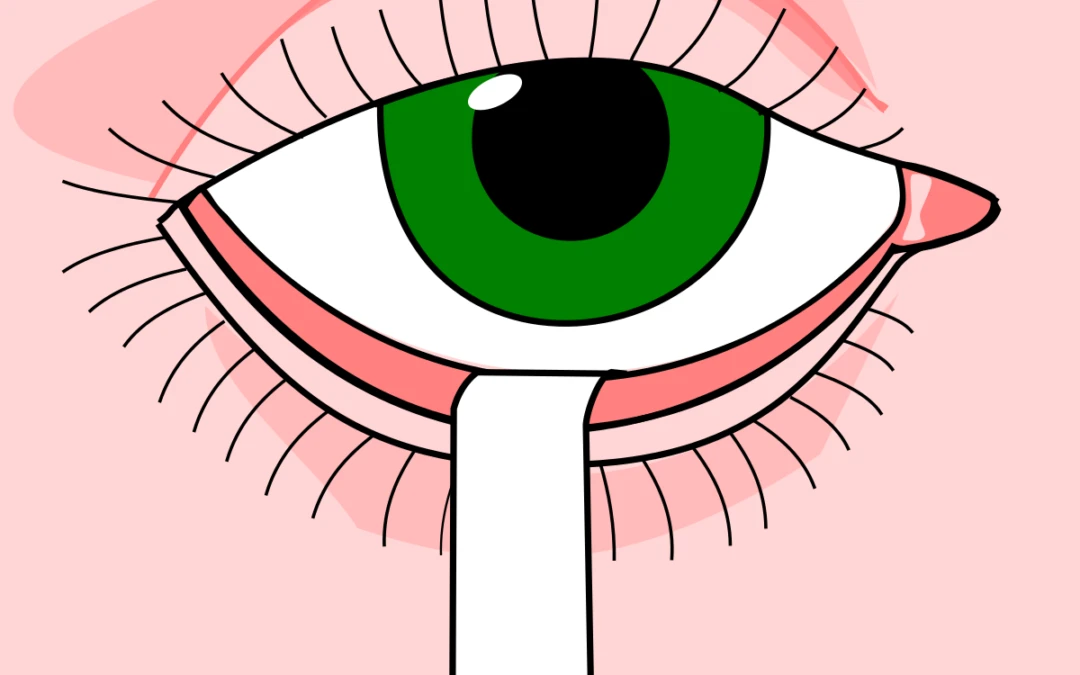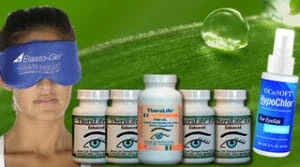Schirmer test is a tear production testing; tears test; dry eye test; basal secretion test.
Your eye doctor will use this Schirmer test determines whether the eye produces enough tears to keep it moist.
The test works by the principle of capillary action, which allows the water in tears to travel along the length of a phenol red thread test strip identically as a horizontal capillary tube. The rate of travel along the test strip is proportional to the rate of tear production.
Eyes are visual organs that are hollow, almost spherical globes stuffed with fluid or humor.
The skin or tunic is dense and protective. The upper layers (the choleoblast ciliate and iris) are vascular. The inner layers of retinas are nervous or sensory. The liquid inside the eye is divided by the lens in the vitreous (under the lens) and aqueous humor.
Another test involves fluorescein eye drops, which contain a dye placed in the eye. The dye should drain with the tears through the lacrimal duct into the nose within 2 minutes.
Another test measures tear osmolarity, or how concentrated the tears are. The higher the osmolarity, the more likely you have dry eye. A typical tear osmolarity test is called Tear Breakup Test. Your eye doctor will watch how long the dyed tear film covers your whole eye. If your tear film does not last long, you may have dry eye.
Schirmer’s test-1 values were determined in clinically normal alpacas (Vicugña pacos) in North America. McDonald JE, Knollinger AM, Dees DD, MacLaren NE. Vet Ophthalmol. 2018 Jan; 21(1):101-103.
What is Schirmer test?
Schirmer’s test determines if you have enough tears to keep your eyes moist. These tests measure tear production.
The Schirmer test or Schirmer tear test (STT) assess tear production, especially in patients with suspected keratoconjunctivitis sicca, dry eye, or tear overproduction.
The test works on the principle of capillaries action, allowing water in tears to travel along the length of a phenol red thread test strip the same way.
The Schirmer tests have been labeled with L or R for the left eye and right eye. The strips are flipped 90 degrees. The speed of the test surface depends on production of tear.
Tell me the purpose of the Schirmer test?
Schirmer’s test is performed when an eye doctor suspects a dry eye and wants to know if your eye produces enough tears. Some symptoms include dry eyes with excessive rubbing of the eyes.
Symptoms include dryness of the eyes or excessive watering of the eyes. Normal Results More than 10 mm of moisture on the filter paper after 5 minutes is a sign of normal production of tear.
Best Oral Dry Eyes Treatment That Works .
Add To Cart
How the Schirmer’s Test will Feel?
It isn’t very pleasant to hold a book in your eye. Sometimes a tingling drop feels stingy.
How the Schirmer’s test is performed
You will be asked to remove your glasses or contact lenses before the test.
The exact procedure may vary.
Schirmer’s test consists of:
Your eye doctor can put the ends of an adhesive film inside each lower eyelid. Both eye tests can be conducted separately.
Before the test, you may be given numbing eye drops to prevent your eyes from tearing due to irritation from the paper.
The eyes are closed for 5 minutes. The paper is then removed, and the amount of moisture is measured. After five minutes, the patient is asked to open both eyes and look upward so may remove the test strip. The Schirmer test score is determined by the length of the moistened area of the strips (using the scale packaged with the strips)
Before the tests, your numbing drops may be used as protection against bruising from paper strips. The precise procedures can vary. Typically an eye closure lasts 5 minutes. Open your eyes lightly. Closing eyes or touching eyes in tests may cause a negative result. After 15 min, the doctor pulls out the paper strips, measuring which part of it is becoming moist. Sometimes tests have no numb drops to test another type of tear.
A modified Schirmer test in dry eye and normal subjects: open versus closed eye and 1-minute versus 5-minute tests.
There is a controversy about whether to use numbing drops for the Schirmer test and how to interpret the results produced.
Schirmer test with open and closed eyes: variations in normal individuals. Arq Bras Oftalmol. 2009 Jan-Feb; 72 (1):65-7. [ PubMed: 19347125 ] 5. Kashkouli MB, Pakdel F, Amani A, Asefi M, Aghai GH, Falavarjani KG.
Clinical significance
The Schirmer test is used in ophthalmic examination to measure production of tear to diagnose conditions like keratoconjunctivitis, scabies, and dry eye.
The symptoms can manifest in several symptoms, such as foreign body or gritty sensations.
The Schirmer test is another common test to assess for dry eye. Also known as a basal secretion test, it measures aqueous tear production.
Keratoconjunctivitis is an infection that affects both eyes and conjunctivitis, and the cornea.
It is more commonly seen in the ear.
Dry eye has been classified into reduced production of tear versus increased tear vaporization subtypes which result in insufficient fluid layers.
What is normal schirmer tear test?
Normal Schirmer test score maximum in 5 mins. The score indicates normal tear production. Both eyes usually give out a single tear.
Your eye doctor will read the results of the Schirmer’s test:
1. Normal is ≥10 mm wetting of the filter paper after 5 minutes.
2. Low tear production is <5 mm wetting of the filter paper after 5 minutes indicating tear deficiency.
3 Alternatives: Although this test has been available for over a century, several clinical studies have shown that it does not correctly identify dry eyes.
Dry eye syndrome
The results need to be correlated with other findings on the eye exam to determine if you have dry eyes.
Dry eye is divided into decreased tear production and increased tear evaporation subtypes. Dry eye syndrome results in an insufficient fluid layer (precorneal tear film) that usually covers the eye.
Learn more about oral treatment for dry eyes
Issues of concern
Some clinical trials demonstrated that Schirmer’s test could not reliably determine the effects on a patient with dry eyes.
Variation resulting in the change in testing method and investigation causes variability. Various studies include comparing the tests using closed eyes compared to open eyes.
Newer and better tests are being developed. One test measures a molecule called lactoferrin. People with low production of tear and dry eye have low levels of this molecule. Another test measures tear osmolarity, or how concentrated the tears are to properly identify dry eyes.
Considerations
Keep eye contact for 15 to 30 minutes. Leave contact lenses on until 2 hours after the tests.
Although Schirmer has been available for nearly 100 years, several studies have shown that this test cannot accurately identify an entire population with dry eyes.
More testing is planned.
These tests measure the metabolites that make lactoferrin.
Tear density
People with low tears have low concentrations of the drug in their bloodstream. Another test measures an osmolar density, the amount and intensity of tears present. The higher the osmolarity, the worse the chances of dry eyes.
Results with or without anesthesia
The Schirmer tear test performed with and without anesthesia evaluates tear adequacy. It often aids in the diagnosis of dry eye syndrome. The Schirmer test performed without anesthesia measures basal and reflex tear secretion. The Schirmer test with anesthesia measures basal tear secretion only.
Sjogren’s syndrome
The most commonly used test for diagnosing Sjogren’s Syndrome is the Schirmer test, performed with a paper strip in the lower eyelid without numbing drops. The test involves measuring the wetting of standardized paper strips applied between the eyeball and the inferior lateral lid.
The test works by the principle of capillary action, which allows the water in tears to travel along the length of a paper test strip identically as a horizontal capillary tube. The rate of travel along the strip is proportional to the rate of tear production.
Tear osmolarity may be a better test for SS.
Schirmer test = 0,00 in Sjögren’s syndrome, abnormal test results.
Nursing, Allied Health, and Interprofessional Team Interventions
A positive Schirmer test alone can never confirm keratoconstriction.
Various underlying mechanisms are involved in dry eye – likewise, specific tests are much more effective in revealing their causes.
Treatments must ideally focus on the particular mechanism that drives the dry eye.
All medical team members involved in patient care must provide information about their patients.
Best Oral Dry Eyes Treatment That Works .
Add To Cart
References
Acute ophthalmological adolescent mortality rates and external ophthalmology mortality. Acute and internal ocular diseases panel. Symptom: Dry eyes. Preference for practice. Ophthalmics. 2019-12-03:283. Id. 3366698 site. Bohn JJ – Dalallian AAR, Pflugfeld SC – Starr E. Wet eyes. In: Manis J, Holland J, editors. Cornelia: Foundational Diagnosis and Management. Fourth edition. Philadelphia: Elsevier 2017, Chapter 32. Feder R.O, Olsen TN, Prum J.E. ct. /. Comprehensive eye exams for adults, guidelines for best practices. Ophthalmology. 2016: 124: 212-246. PMID 26681558. Sites.






